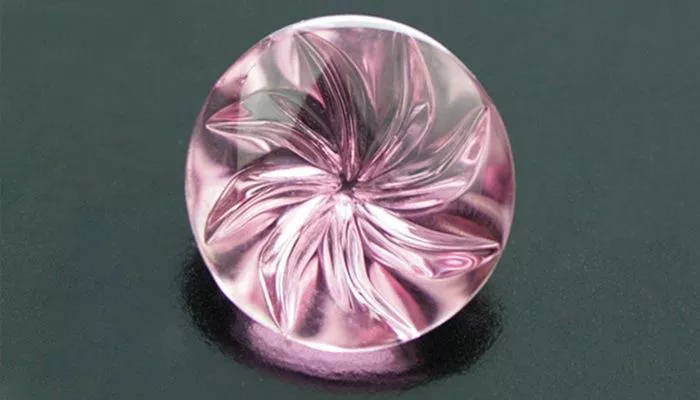Pink tourmaline, a gemstone that captivates the heart with its delicate hues and shimmering brilliance, is a cherished addition to any jewelry collection. However, with the proliferation of imitations and treated stones in the market, identifying genuine pink tourmaline can be challenging. This guide aims to provide a detailed, professional, and easy-to-understand approach to distinguishing natural pink tourmaline from its counterparts.
Understanding Pink Tourmaline
Tourmaline is a semi-precious gemstone known for its diverse color palette, ranging from deep greens and blues to vibrant pinks and reds. Pink tourmaline, specifically, is valued for its soft, romantic hues that make it a perfect choice for jewelry pieces such as rings, pendants, and earrings.
Natural vs. Treated and Synthetic Stones
Natural pink tourmaline occurs in various shades, from light pink to deep rose. However, some stones may undergo treatments to enhance their color or clarity. These treatments can sometimes obscure the natural characteristics of the gemstone, making identification difficult. Synthetic tourmaline, on the other hand, is produced in laboratories and often lacks the natural imperfections and inclusions found in genuine stones.
Visual Inspection
Color and Tone
Natural pink tourmaline exhibits a bright and consistent color with no noticeable color zoning or striations. The color should be pure pink, without any hints of brown, gray, or other unwanted tones. When inspecting a pink tourmaline, hold it against a neutral background to observe its true color and saturation.
Clarity and Transparency
Clarity is another crucial factor in identifying pink tourmaline. High-quality natural stones are typically transparent to translucent, with minimal internal flaws or inclusions. However, some natural pink tourmalines may contain internal structures such as needle-like inclusions or fluid-filled cavities. These natural imperfections are often absent in synthetic stones, which tend to be flawless.
When examining clarity, look for any signs of cloudiness, cracks, or internal bubbles. These can indicate that the stone has been treated or is synthetic. High-quality natural pink tourmaline should have a clear, vibrant appearance with minimal internal imperfections.
Luster and Refractive Properties
The luster of pink tourmaline is another distinguishing feature. Natural stones exhibit a vitreous to adamantine luster, which means they reflect light in a bright, sparkling way. In contrast, synthetic stones may have a duller, glass-like appearance.
To further test the refractive properties of the stone, place a single hair strand on its surface and observe it through the gemstone. If the hair appears doubled or distorted, it indicates that the stone has a high refractive index, which is a characteristic of natural tourmaline. Synthetic stones, with a lower refractive index, will not produce this effect.
Physical Tests
Hardness Test
Pink tourmaline has a hardness rating of 7 to 7.5 on the Mohs scale, which makes it relatively scratch-resistant. To perform a hardness test, gently scratch the stone’s surface with a hard object, such as a steel knife or a piece of glass. If the stone remains unscathed, it is likely natural tourmaline. However, be cautious with this test, as excessive scratching can damage the gemstone.
Density and Specific Gravity
The density or specific gravity of pink tourmaline can also provide clues about its authenticity. Natural tourmaline typically has a specific gravity ranging from 3.0 to 3.3. To measure this, you can use a precise scale and a known volume of water. Place the stone in water and measure the displacement to calculate its density.
Advanced Identification Techniques
Spectral Analysis
Spectral analysis involves using specialized instruments to examine the absorption and emission patterns of light within the gemstone. Natural pink tourmaline exhibits unique absorption bands in the ultraviolet, visible, and infrared regions of the spectrum. These bands can help distinguish natural stones from synthetic or treated ones.
Thermal Conductivity Testing
Thermal conductivity testing measures how quickly heat is transferred through the gemstone. Natural pink tourmaline has a relatively low thermal conductivity compared to other gemstones like diamonds. Using a thermal conductivity tester, you can quickly determine if a stone is tourmaline or another gemstone with higher thermal conductivity.
Common Imposters and Treatments
Glass and Synthetic Materials
Glass and synthetic materials are common imposters for pink tourmaline. Glass, in particular, can be dyed to resemble the color of natural tourmaline. However, glass lacks the natural luster and refractive properties of tourmaline. Synthetic tourmaline, while visually similar, often lacks the internal imperfections and growth patterns found in natural stones.
Heat and Irradiation Treatments
Some pink tourmalines undergo heat or irradiation treatments to enhance their color. These treatments can change the stone’s hue and saturation, making it appear more vibrant. However, treated stones may also exhibit color zoning or other telltale signs of treatment under close examination.
Authentication and Certification
To ensure the authenticity of your pink tourmaline, obtain a certification from a reputable gemological laboratory. These laboratories use advanced analytical techniques to verify the stone’s composition, origin, and treatment history. A certification report will provide detailed information about the gemstone’s physical and optical properties, as well as any treatments it may have undergone.
Conclusion
In summary, pink tourmaline is a cherished gemstone known for its delicate hues and shimmering brilliance. Identifying genuine pink tourmaline involves a thorough understanding of its natural characteristics, including color, clarity, luster, and refractive properties. Advanced techniques such as spectral analysis and thermal conductivity testing can provide further insights. Always obtain certification from a reputable gemological laboratory to ensure the authenticity of your gemstone. With this guide, you can confidently navigate the world of pink tourmaline and add this stunning gemstone to your jewelry collection.
Related topic:
- Can Tourmaline Be Worn Everyday
- Why Is Watermelon Tourmaline so Expensive
- What Are the Healing Properties of Black Tourmaline


